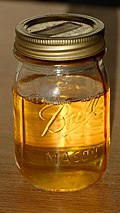Turpentine (which is also called gum turpentine, spirit of turpentine, oil of turpentine, wood turpentine, terebenthene, terebinthine and (colloquially), turps)[3] is a fluid obtained by the distillation of resin harvested from living trees, mainly pines. Mainly used as a specialized solvent, it is also a source of material for organic syntheses.
Turpentine is composed of terpenes, primarily the monoterpenes alpha- and beta-pinene, with lesser amounts of carene, camphene, dipentene, and terpinolene.[4]
The word turpentine derives (via French and Latin), from the Greek word τερεβινθίνη terebinthine, in turn the feminine form (to conform to the feminine gender of the Greek word, which means "resin") of an adjective (τερεβίνθινος) derived from the Greek noun (τερέβινθος), for the tree species terebinth.[5] Mineral turpentine or other petroleum distillates are used to replace turpentine – although the constituent chemicals are very different.[6]
https://en.wikipedia.org/wiki/Turpentine
White spirit (UK & Ireland)[note 1] or mineral spirits (US, Canada), also known as mineral turpentine (AU/NZ), turpentine substitute, and petroleum spirits, is a petroleum-derived clear liquid used as a common organic solvent in painting.[1] There are also terms for specific kinds of mineral spirits, including Stoddard solvent and solvent naphtha (petroleum). Mineral spirits are often used as a paint thinner, or as a component thereof, though paint thinner is a broader category of solvent. Odorless mineral spirits (OMS) have been refined to remove the more toxic aromatic compounds, and are recommended for applications such as oil painting.
A mixture of aliphatic, open-chain or alicyclic C7 to C12 hydrocarbons, white spirit is insoluble in water and is used as an extraction solvent, as a cleaning solvent, as a degreasing solvent and as a solvent in aerosols, paints, wood preservatives, lacquers, varnishes, and asphalt products. In western Europe about 60% of the total white spirit consumption is used in paints, lacquers and varnishes.[1] White spirit is the most widely used solvent in the paint industry. In households, white spirit is commonly used to clean paint brushes after use, to clean auto parts and tools, as a starter fluid for charcoal grills, to remove adhesive residue from non-porous surfaces, and many other common tasks.
The word "mineral" in "mineral spirits" or "mineral turpentine" is meant to distinguish it from distilled spirits (distilled directly from fermented grains and fruit) or from true turpentine (distilled tree resin).
Types and grades[edit]
Three different types and three different grades of white spirit exist. The type refers to whether the solvent has been subjected to hydrodesulfurization (removal of sulfur) alone (type 1), solvent extraction (type 2) or hydrogenation (type 3).[2]
Each type comprises three grades: low flash grade, regular grade, and high flash grade (flash refers to flash point). The grade is determined by the crude oil used as the starting material and the conditions of distillation.[2]
In addition there is type 0, which is defined as distillation fraction with no further treatment, consisting predominantly of saturated C9 to C12 hydrocarbons with a boiling range of 140–200 °C (284–392 °F).[3]
Stoddard solvent is a specific mixture of hydrocarbons, typically over 65% C10 or higher hydrocarbons,[4] developed in 1924 by Atlanta dry cleaner W. J. Stoddard and Lloyd E. Jackson of the Mellon Institute of Industrial Research as a less flammable petroleum-based dry cleaning solvent than the petroleum solvents then in use.[5][6] Dry cleaners began using the result of their work in 1928 and it soon became the predominant dry cleaning solvent in the United States, until the late 1950s.[7]
Turpentine substitute is generally not made to a standard and can have a wider range of components than products marketed as white spirit, which is made to a standard (in the UK, British Standard BS 245, in Germany, DIN 51632). Turpentine substitute can be used for general cleaning but is not recommended for paint thinning as it may adversely affect drying times due to the less volatile components; while it may be used for brush cleaning its heavier components may leave an oily residue.
In Australia, white spirit is normally sold under the generic name of Shellite (a trademark of Shell Australia), and is composed of C6 to C10 straight alkanes, classing it as light pure naphtha. It is used for fuel and cleaning.[citation needed]
https://en.wikipedia.org/wiki/White_spirit


No comments:
Post a Comment